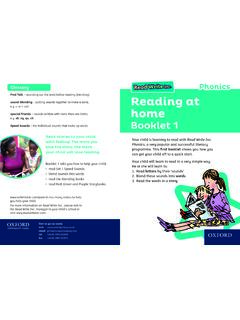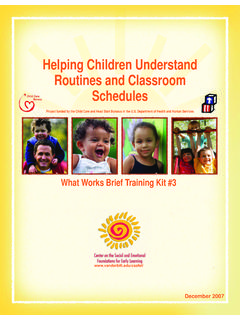Transcription of Managing Behaviour in the Primary Classroom
1 Managing Behaviour in the Primary Classroom : a Research Brief for Primary Practitioners 1 Research Brief Managing Behaviour in the Primary Classroom : a Research Brief for Primary Practitioners National Foundation for Educational Research (NFER) Managing Behaviour in the Primary Classroom : a Research Brief for Primary Practitioners Kerry Martin Amanda Harper Published in June 2014 By the National Foundation for Educational Research, The Mere, Upton Park, Slough, Berkshire SL1 2DQ 2014 National Foundation for Educational Research and Oxford University Press ISBN 978-1-910008-23-2 How to cite this publication: Martin, K. and Harper, A. (2014). Managing Behaviour in the Primary Classroom : a Research Brief for Primary Practitioners. Slough and Oxford: NFER and Oxford University Press. Contents 1 Background and context to Behaviour management in Primary schools 1 2 Effective Behaviour management practices and approaches: evidence from the research 2 Effective whole-school Behaviour management approaches 2 Effective Classroom Behaviour management strategies 5 3 Conclusions and action points 9 References 11 Managing Behaviour in the Primary Classroom : a Research Brief for Primary Practitioners 1 1 Background and context to Behaviour management in Primary schools We know that effective Behaviour management underpins successful teaching and learning.
2 Primary schools with good or outstanding Behaviour judgements, for example, have been found, on average, to have higher percentages of pupils with better outcomes in English and maths at Key Stage 2, compared with schools with satisfactory or inadequate Behaviour judgements (DfE, 2012). The standard of Behaviour in most schools in England is good. According to schools inspectorate, Ofsted, our schools are mostly calm, well-managed places and poor Behaviour is less of an issue now than it has been in the past (Ofsted, 2012). Teachers seem to agree; a recent survey, for example, found that 85 per cent of Primary teachers reported that Behaviour in their school was very good or good (Aston and Weaving, 2013). Despite this, there are ongoing issues relating to the low-level disruption that manifests in some schools. As a result, a new programme of unannounced inspections for schools has been introduced where behavioural standards are giving cause for concern (Ofsted, 2014).
3 This briefing looks at some of the effective whole-school and Classroom -based approaches to improving Behaviour . It is not intended to be an in-depth review of all Behaviour management strategies and their effectiveness. Instead, it highlights key findings from a small number of relevant reports and research studies from England, which are of particular relevance to Primary practitioners. This briefing: considers some of the research evidence on effective Behaviour management details what some schools have done by providing case-study examples of Behaviour management approaches and techniques implemented in Primary school settings outlines what you can do in practice by summarising the key recommendations and action points from the research and guidance for Primary school practitioners. 2 Managing Behaviour in the Primary Classroom : a Research Brief for Primary Practitioners It is a must do document, but we find this to be supportive rather than restrictive.
4 By having a common approach to what we call baseline issues we support each other and pupils understand our expectations. Our policy is reviewed each year and is a subject for constant discussion (Steer, 2009, p. 20). 2 Effective Behaviour management practices and approaches: evidence from the research There is no single solution to the problem of poor Behaviour , but all schools have the potential to raise standards if they are consistent in implementing good practice in learning, teaching and Behaviour management (Steer, 2009, p. 26). The following sections provide details of what key government reports and research studies say about effective school-level strategies and Classroom -based approaches to Behaviour management in the Primary school setting. Effective whole-school Behaviour management approaches School Behaviour policy A school s Behaviour policy plays an essential role in achieving good Behaviour across a school.
5 According to Steer (2009), if a school Behaviour policy is to be meaningful it needs to be reviewed on a regular basis and communicated often to pupils, staff and parents/carers. If this does not happen, it is unlikely to have much impact. Such policies should also be informed by an audit of the Behaviour needs within the school. This should include the nature of the negative behaviours displayed by pupils; background details and characteristics of the individuals responsible; the location in which incidents occur and; an assessment of the successfulness of the interventions implemented. A study of Primary and secondary schools in the North of England with high rates of deprivation identified differences in school ethos between schools that used exclusion from school as a disciplinary measure and those that did not. The research by Hatton (2012) found that staff in schools that excluded pupils tended to think that both teachers and pupils had insufficient understanding of the Behaviour policy.
6 There was also a view that staff did not take a consistent approach to Behaviour management across school. Staff development and support All staff should be equipped with the skills to understand and effectively manage pupil Behaviour . Providing regular training, which links Classroom practice to an understanding of children s social and emotional development is key (Ofsted, 2005). Training and coaching should be made available to all staff taking up new posts at the school and form part of an ongoing training programme for existing staff. Staff development is just as important for Managing Behaviour in the Primary Classroom : a Research Brief for Primary Practitioners 3 Our senior managers recognise that, as the term goes on and we get tired, we sometimes forget to follow through agreed practices. In briefings they gently remind us about simple things like smiling at children, saying good morning and getting to classrooms on time (Steer, 2009, p.)
7 21). experienced staff as it is for Newly Qualified Teachers (NQTs) and support staff. A thorough induction programme can help schools with a high staff turnover to ensure consistency in approach (Steer, 2009). Top tips for ensuring effective staff training and development Ensure that all staff joining the school receive induction training that covers Behaviour management . Provide opportunities for all staff to regularly share and develop their skills in promoting positive Behaviour . Ensure funds are allocated within training budgets to enable support staff to be involved in training programmes with teachers. Create opportunities for staff to learn from the expertise of those with a particular responsibility for pupils whose Behaviour is challenging ( teachers who manage nurture groups, staff from Pupil Referral Units or other alternative provision, and specialist Behaviour support staff).
8 Develop the specialist skills of individual staff members that have particular leadership responsibilities for improving Behaviour . Monitor the effectiveness of the Behaviour management techniques used across the school as part of the school performance management system (Steer, 2009). Leadership and management Effective leadership is key to Managing pupil Behaviour . According to Ofsted (2005), the most difficult Behaviour is almost always managed well in schools where senior leaders provide clear direction and reassurance to staff. These effective leaders monitor the management of pupil Behaviour and their regular presence around the school creates a sense of calm and order. It is important for senior managers to observe the behavioural difficulties that class teachers experience so they have an understanding of the range of challenges they face. This helps to ensure that appropriate interventions are put in place across the school.
9 It is also essential to provide regular opportunities for staff to discuss Behaviour issues and observe effective Behaviour management practices within their own school and in other local schools. Good-quality written guidance on Behaviour , for example, in staff handbooks and displayed in accessible places such as staffrooms, helps new staff to get up to speed with the specific standards and expectations of the school. Written guidance should be reinforced by a thorough staff induction programme, as well as ongoing reminders about behavioural expectations (Ofsted, 2005). 4 Managing Behaviour in the Primary Classroom : a Research Brief for Primary Practitioners Rewards and sanctions According to Steer (2009), schools with good standards of Behaviour achieve a balance between the use of rewards and sanctions. Praise is used to motivate and encourage pupils. At the same time, pupils need to be aware of the range of interventions and penalties that could be applied if they misbehave.
10 In a survey of Primary teachers, 18 per cent said their school uses same-day detentions and 46 per cent said they would use physical means to remove a disruptive pupil from the Classroom (Aston and Weaving, 2013). Practice example: Adopting a whole-school system of rewards and sanctions In order to achieve a consistent approach to Behaviour management , one Primary school adopted a yellow card system at lunchtimes. If any pupil exhibits poor Behaviour they are given a yellow card. If they are awarded three cards at any one time, they receive an automatic detention. Any member of teaching or support staff can issue a card. A member of staff must witness and acknowledge the pupil displaying good Behaviour on two separate occasions before they can return their yellow card back to a member of staff. Commenting on the success of the card system, a member of staff commented: Initially we were inundated with cards but now the system acts as a deterrent and so we find that the number of cards in circulation is very small.












